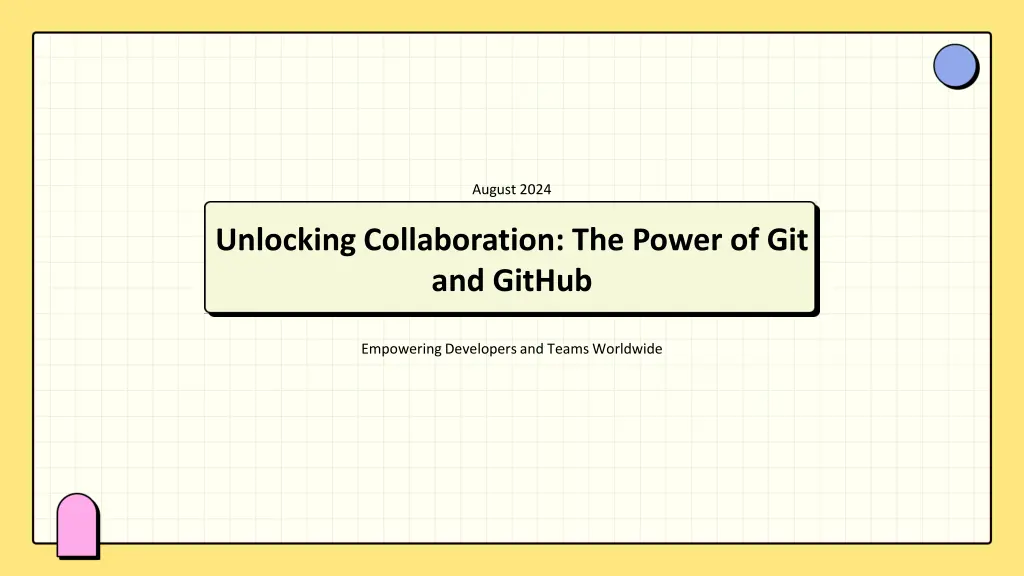
Empowering Collaboration Through Git and GitHub: A Developer's Guide
Explore the power of Git and GitHub in fostering seamless collaboration among developers and teams worldwide. Understand the importance of version control, repositories, branching, and merging for efficient project management. Learn how GitHub enhances code sharing and project tracking, promoting community collaboration and innovation.
Download Presentation

Please find below an Image/Link to download the presentation.
The content on the website is provided AS IS for your information and personal use only. It may not be sold, licensed, or shared on other websites without obtaining consent from the author. If you encounter any issues during the download, it is possible that the publisher has removed the file from their server.
You are allowed to download the files provided on this website for personal or commercial use, subject to the condition that they are used lawfully. All files are the property of their respective owners.
The content on the website is provided AS IS for your information and personal use only. It may not be sold, licensed, or shared on other websites without obtaining consent from the author.
E N D
Presentation Transcript
August 2024 Unlocking Collaboration: The Power of Git and GitHub Empowering Developers and Teams Worldwide
Table of Contents 5 Collaboration Made Easy 1 The Foundation of Version Control 6 Continuous Integration and Deployment 2 Understanding Repositories The Role of GitHub 7 Embracing Open Source 3 Branching and Merging 8 Best Practices for Git and GitHub 4
9 The Future of Collaboration 10 Thank You for Your Attention!
The Foundation of Version Control 1. Git is a distributed version control system that allows multiple developers to work on the same project simultaneously without overwriting each other's changes. 2. Introduced by Linus Torvalds in 2005, it has become the standard version control system for developers. 3. Git tracks changes and maintains a history of the codebase, enabling robust collaboration. 4. With Git, developers can create branches for new features, promoting experimentation and innovation. 5. This system makes reverting to previous states easy, ensuring that mistakes can be corrected seamlessly.
Understanding Repositories 1. At the core of Git is the concept of repositories, which are storage spaces for projects. 2. Repositories can be local (on your computer) or remote (hosted on platforms like GitHub). 3. Each repository contains all files, history, and commits, making it a complete project package. 4. With Git, you can clone repositories, allowing developers to contribute to open-source projects effortlessly. 5. This fosters community collaboration and promotes shared learning in coding.
The Role of GitHub 1. GitHub is a web-based platform built on top of Git that enhances collaboration and sharing of code. 2. It provides a user-friendly interface for managing projects and tracking issues. 3. GitHub s features like pull requests make it easy to propose changes and review code collaboratively. 4. With social networking capabilities, developers can follow each other and discover projects of interest. 5. It serves as a portfolio for developers, showcasing their work to potential employers.
Branching and Merging 1. Branching is a critical feature that allows developers to create a separate line of development for new features or fixes. features or fixes. 2. It prevents conflicts and keeps the main codebase stable while changes are made. 3. Merging integrates changes from different branches, allowing for a unified project. 4. Effective branching strategies foster efficient workflows and project management. 5. Having a clean and organized branch structure is key for team collaboration.
Collaboration Made Easy 1. Git and GitHub revolutionize teamwork by minimizing conflicts and misunderstandings among developers. 2. Real-time collaboration is supported, enabling teams to work together regardless of location. 3. Code reviews and discussions on pull requests foster a learning environment. 4. The ability to track contributions encourages accountability and recognition among team members. 5. This collaborative spirit ultimately leads to higher quality software.
Continuous Integration and Deployment 1. GitHub integrates with various Continuous Integration/Continuous Deployment (CI/CD) tools. 2. This allows teams to automate testing and deployment processes efficiently. 3. Automating these workflows minimizes manual errors and speeds up the release cycle. 4. Developers can focus on writing code while the system handles deployments. 5. This seamless process enhances project delivery timelines and product quality.
Embracing Open Source 1. Git and GitHub play a vital role in the open-source movement, enabling collaboration on public projects free from restrictions. 2. This encourages innovation and rapid advancement in technology as anyone can contribute. 3. Open-source projects foster a sense of community and allow new developers to learn from experienced ones. 4. Participating in open source can enhance your skills and visibility in the tech industry. 5. It cultivates a culture of sharing knowledge and resources freely.
Best Practices for Git and GitHub 1. Effective use of Git and GitHub requires adhering to best practices for maximum efficiency. 2. Writing clear commit messages is essential for maintaining project history. 3. Regularly syncing with remote repositories ensures everyone is on the same page. 4. Using branches strategically can prevent conflicts and increase productivity. 5. Lastly, always review code thoroughly to maintain high quality standards.
The Future of Collaboration 1. As technology advances, the need for efficient collaboration tools continues to grow. 2. Git and GitHub are consistently evolving, integrating new features to meet modern development needs. 3. The rise of cloud computing and remote work highlights the importance of such tools. 4. Continuous improvement in collaboration practices can lead to more innovative solutions. 5. Embracing these technologies now prepares us for the future of development.
Thank You for Your Attention! 1. Thank you for exploring the world of Git and GitHub with us today! 2. We hope you feel inspired to harness these tools for your own projects and teamwork. 3. Remember, innovation thrives when we collaborate effectively. 4. Stay curious, keep coding, and don't hesitate to embrace the open-source community. 5. Let's build the future together!
